Key Themes
When Matthew Bourne premiered his version of Swan Lake in 1995 it caused quite a stir. Since its first airing audiences and reviewers have grown accustomed (and impassioned) by Matthew’s bold, contemporary adaptations to well-known classics. Yet back in 1995 the curtains were about to be raised on the largest and perhaps most daring of all of his interpretations and the very notion of replacing traditionally female roles with male ones, was ruffling a few feathers – if you’ll excuse the pun. Yet, it was also being greeted as a breath of fresh air and has since become perhaps the best-known, and loved, of all his works.
It was instantly apparent that Matthew’s re-take on this timeless tale – already staged by hundreds of ballet companies all over the world since its creation by Julius Reisinger for the Bolshoi Ballet (1877), and then most famously by Lev Ivanov and Marius Petipa in 1895 for the Imperial Ballet - was the freshest and most innovative of its kind. At one point, it was impossible to comprehend a flight of male swans taking to the stage, and now their arrival in Act II is the moment audiences wait for with heady anticipation.
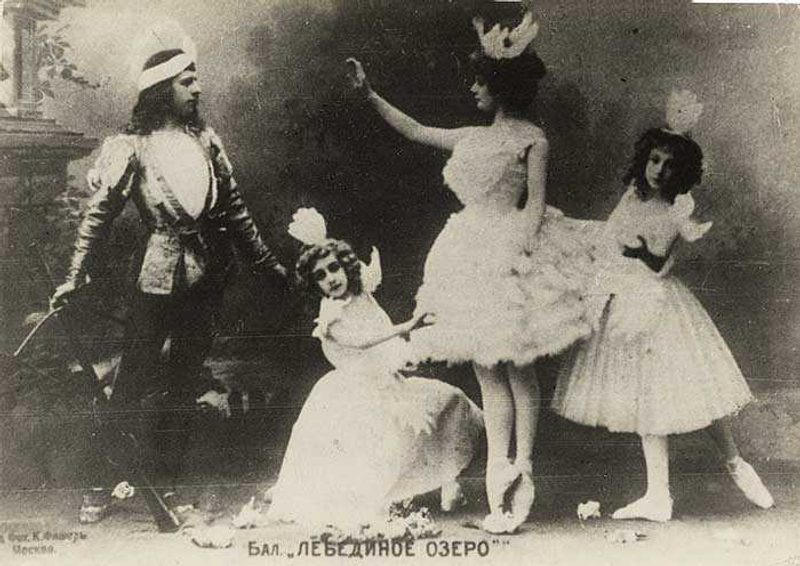
Ever since it first began filling auditoriums Matthew’s version of Swan Lake has charmed, challenged and intrigued. The imagery associated with it – in particular the bare-chested, white-painted male dancers with feathered ‘trousers’ – has become iconic.
But aside from the obvious deviations from the historic versions of Swan Lake including switching up the geographical location (originally said to have been inspired by Russian and/or German folklore, Matthew’s version is based in London), bringing it up to date (Matthew’s version travels through the 1950s, 60s and present day, as opposed to drawing on 19th and 20th century influences) and replacing traditionally female roles with male ones, how much is actually that different?

The themes that have captured viewers’ hearts for centuries, remain very much central to Matthew’s version but with a modern coating. At its heart, Swan Lake has all the ingredients of any fast-paced, prime-time TV thriller – there’s longing, betrayal, jealousy, dominance, power and temptation. It’s a compelling story of hope, despair and the rocky and treacherous road that lies between the two.
What makes Matthew’s version most appealing, perhaps, is its relatability. By setting the story in 21st century England, we feel intensely connected to the piece and the characters in it.
So, let’s look now at some of the key themes that drive Matthew’s interpretation of ‘his’ Swan Lake.
For some of the themes we have also included some notes relating to the inspiration behind them, and some moments from the show that exemplify these.
Theme One: Family
The intricacies and complexities of familial ties and the hurt and damage often caused by those closest to us forms the beating heart of Swan Lake. Immense strain is placed upon the traditional mother/son relationship due to the fact that they are Queen and Prince. Protocol, duty and the burden of public service create an emotional chasm between the two, and we see a Prince clearly desperate for his mother’s affection.
Encumbered with Royal obligations and surrounded by up-tight aides and a burgeoning entourage wherever she goes, the Queen appears distant and unloving. The detachment and severance we see her exhibit in relation to the Prince, is starkly contrasted by the intense interest she shows in every other male figure around her.
The Prince is child-like in his constant search for affection and approval from his mother. He longs for reassurance and tenderness, but is consistently rebuffed.
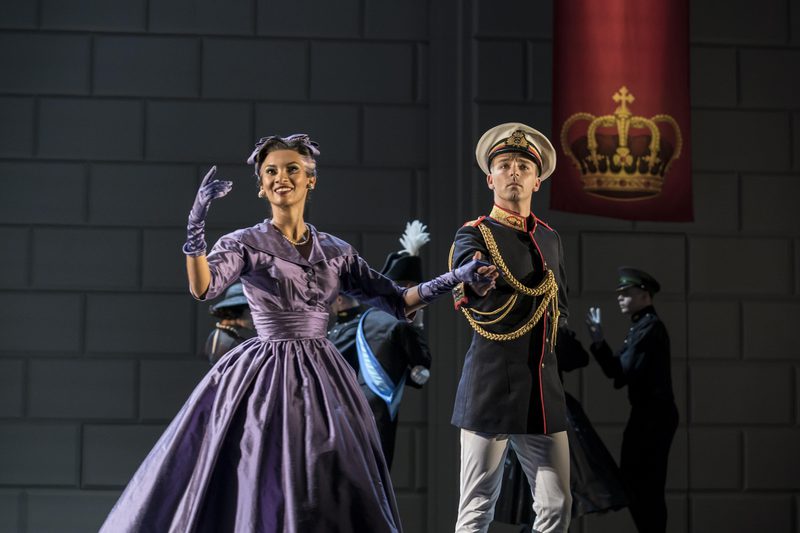
Matthew’s inspiration…
- Matthew was first inspired to create a group of male swans, but he references the Royal aspect of the show as being the second idea that made him know that Swan Lake was worth doing and that it would work. In 1995, there was a lot of scandal surrounding the British Royal Family – including with Diana Princess of Wales and Sarah Ferguson, The Duchess of York – that Matthew felt could be applied to Swan Lake.
- The hounding of the Royal Family; and the fact that it is impossible for them to have a relationship with another person without intrusion was also an influence; and Matthew references Prince Charles and Camilla Parker Bowles in this respect.
- The lack of warmth and tenderness between parents with Royal status and their children heavily influenced the relationship between the Queen and the Prince. Shakespeare’s Hamlet, especially Hamlet’s jealousy of his mother’s love of other men, was a particular influence of this too.
What to look out for?
- The throngs of adoring Royal followers that follow the Queen and the Prince at their public engagements and wait outside the Palace gates to wave and take photos.
- The press photographers who snap photos of the Prince as he stumbles drunkenly out of the bar.
- The Prince’s consistent attempts at garnering affection from his mother, which are ignored by the Queen.
- The Prince’s jealousy and rage every time the Queen gives attention to other men, most notably in relation to her interest in the Stranger – a double whammy for the Prince since the Stranger reminds him of the Swan.
Theme Two: Power
Wealth, status, opulence, greed and the false veneer of happiness that these paint across the main characters are familiar concepts. The family who supposedly have everything are in-fact poor in all the ways that matter most: lacking in love, kindness and freedom of choice.
The Queen undoubtedly wields significant power – not just over her loyal subjects and admiring public - but over her son, too. The Prince is being honed for a life of conformity, acceptance and selfless service, yet beyond him lies a world of raw emotion and authenticity that beckons to him.
All that he desires seems to be represented in the guise of a male swan. The power that the Swan exerts over the Prince is tangible. This beautiful, alluring figure of masculinity, transcendence and opportunity is hard to ignore. He appears when the Prince is at his lowest ebb down by the lake in Act Two and leads him on a fevered quest for the passionate intensity and freedom his own life lacks so desperately.
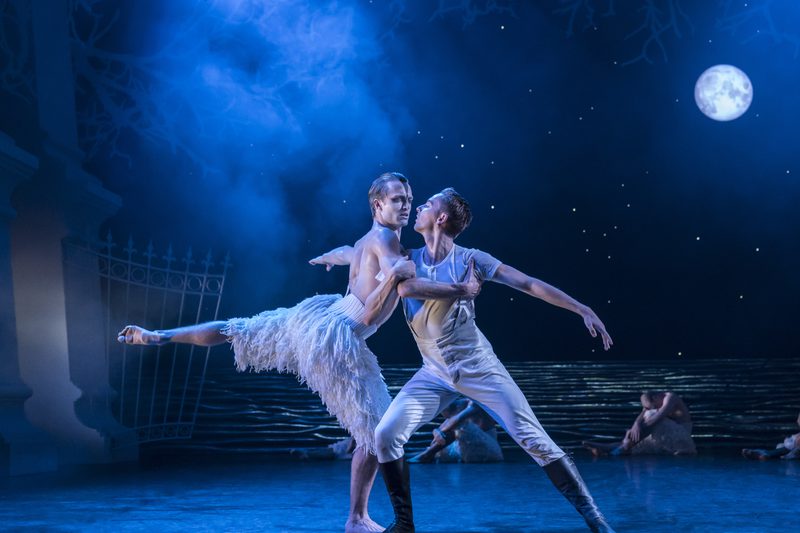
Matthew’s inspiration…
- There are some personal influences that helped shape the role of the Prince as Matthew explains in his conversations with Alastair Macauley, a book first published in 2000: "When I was making [Swan Lake] I had had a lot of rejections; and I hadn’t been in a relationship for a while – before which I’d gone through a difficult ending to a long-term relationship. So yes: I think all that must have affected it quite a lot. That may be what drove some of the Prince’s emotional neediness in my mind – also the strange worship of a symbol, of a beautiful male creature-person. I suppose, I have always had that in my life – people that you have a feeling for from a distance."
What to look out for?
- The endless repetition of the Queen and the Prince’s royal duties and the pressure this seems to place on them. It is clear that the Prince is struggling to hide his disinterest.
- The freedom the Prince longs for so desperately is represented by the Swan. Significantly, imagery of flying swans is suggestive of a world beyond the confines of the palace.
Theme Three: Desire
In the book, 'Matthew Bourne and His Adventures in Dance – Conversations with Alastair Macauley', Matthew describes a common thread within many of his works being a theme of sexual longing:
“I always see that as the basis of a good story. I’m very ‘into’ the dramatic structure of having sets of characters – as in the old style traditions of drama: I like my central couple connected by love or desire, my comic character people on the sidelines, and a villain too.”
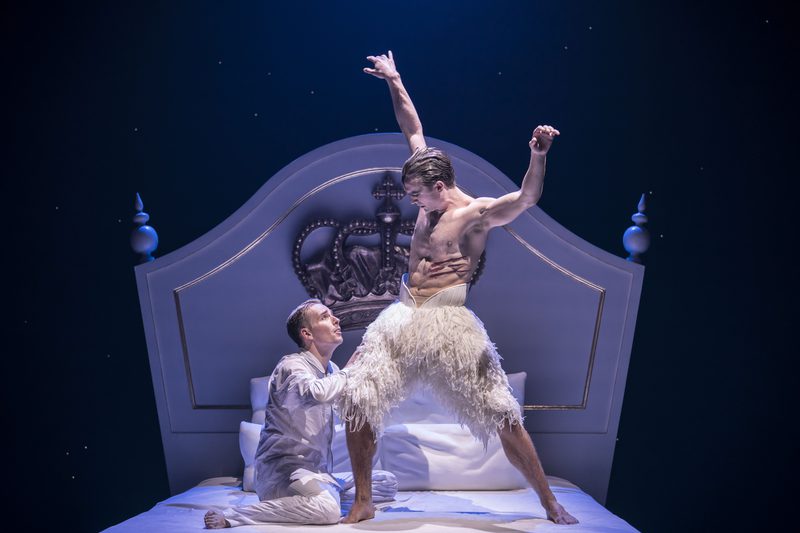
Matthew’s interpretation of Swan Lake is dripping in desire. The Queen is desperate to fulfil her inherited duty as the ruling monarch (to the detriment of her capacity to be a loving mother). She also desires the affections and sexual interest of all the men around her – with apparent ignorance of the harm this does to her son.
The Prince longs for assurance, protection and validation from his mother. When the Swan entices him into a world of new possibility flickers of sensuality, passion and attraction are lit. Whilst this desire isn’t overtly sexual as it is between the Queen and her many male admirers, this may certainly be an interpretation arrived at by some.
As with all of Matthew’s works the audience are given the freedom to draw their own conclusions, but it is certainly apparent that the depth and intimacy of the Prince’s association with the Swan / Stranger is unlike any other relationship he’s ever experienced. He is captivated by the Swan / Stranger and the devastation he subsequently endures when this figure betrays him in Act III is evidence of this.
Though as we all know it is the Prince who has betrayed his own self. His fear and weakness of mind the true cause of his undoing. To everyone’s relief the Swan re-emerges as the Prince’s protector in Act IV and it is at this point obvious that the bonds that tie them together, run both ways.
Theme Four: Jealousy
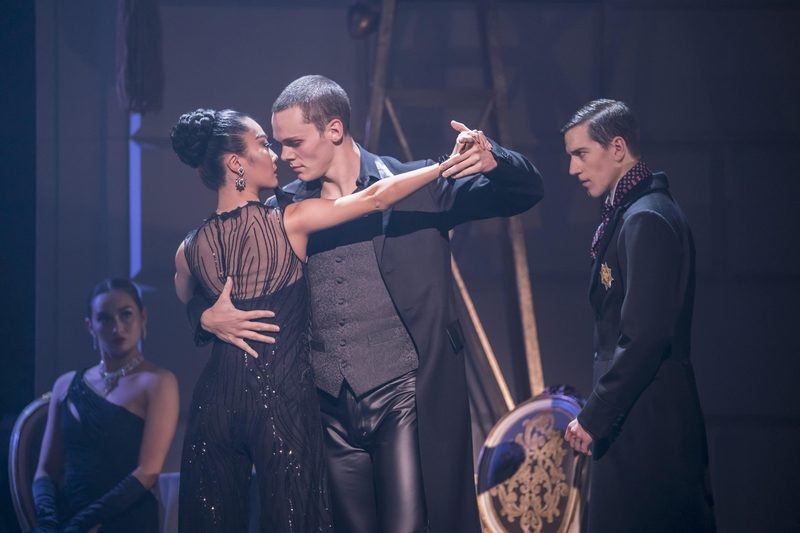
With desire comes jealousy – another key feature in many of Matthew’s works. This powerful emotion is one that Matthew has utilised to trigger significant suffering for central characters previously, (such as Clara in Nutcracker! and Cinderella), and is used with the same success in Swan Lake.
The Prince envies the freedom and ‘carefree-ness’ of the men and women he meets in the bar scene in Act I. Their disregard for rules and regulations and lack of inhibitions mock his sequestered existence as a Royal and whilst he tries hard to join in he is forever destined to be the ‘outsider’.
The Prince also covets his mother’s affections yet she is preoccupied with a string of lovers – and to add insult to injury they are all of a similar age to the young Prince. Jealousy bubbles beneath his seemingly childlike need for maternal tenderness.
Some of the most potent pangs of envy are felt when the Prince observes the Stranger – all whip, leather shirt and leather trousers – making advances on a series of women at the Royal Ball, including most significantly with the Queen. The Stranger represents the power, confidence, sensuality, sexuality and physical and emotional longing that the Prince craves.
The most disruptive and powerful jealousy experienced by the Prince is undoubtedly that of the alternate life he hungers for – of which the Swan (beauty, peace, freedom) and the Stranger (liberty from repression, potency, passion) are the perfect dual metaphors for.
Theme Five: Hope
The Prince continually hopes for something more - something enriching and fulfilling beyond the palace walls. It is his vulnerable investment in the notion that ‘out there’ lies a warmer, more tender world that sees him begin his quest for personal fulfilment. Without the regulation and order laid-out by Royal duty perhaps the Prince can find true happiness?
His ‘neediness’ and susceptibility to external influences is the root of the Queen’s frustration. You can almost feel her exasperation as she continually rebukes his pleas for affection. Her hope is that he’ll grow up, find himself a suitable partner and get on with life as next in-line to the throne.
Hope is ultimately the emotion that captures and compels the viewer too. It is impossible to watch the push-pull between the Swan and the Prince, without ardently wishing for there to be a resolution to the Prince’s internal conflict - demonstrated so beautifully by the oscillation of their physical interplay - before the curtains close.
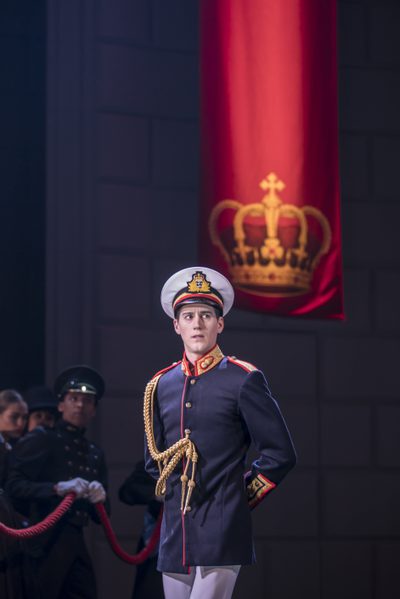
Matthew’s inspiration…
- "When I’m asked to sum up what Swan Lake is all about, I say that it’s about a very simple thing. It’s about somebody who needs love: who needs, in the most basic and simple way, to be held." - Matthew is of course, talking about the Prince. His need for his mother’s love is a thread that runs throughout the story.
- Not having his needs met drives the Prince to imagine a different reality for himself; which is represented by the imagery of swans – symbolic of strength and freedom.
What to look out for?
- The Prince’s distracted daydreaming during his Royal engagements.
- His persistent attempts at winning the Queen’s affection; including during a dramatic duet in which he physically fights for the tenderness he so desperately hopes for.
- The emergence of a flying swan on the outside of the nightclub, which lures the Prince away from the deserted streets.
Theme Six: Duty
The burden of royal duty is entrenched throughout Matthew’s version of the story and the main characters’ actions are guided by the restrictions their position in society places on them. The Queen seems both enlivened by her role as monarch, whilst also at times sobered by it. It is the Prince that clearly struggles most by the expectations of his office. The Private Secretary is a constant and nagging reminder of all that he is required to do. Distractions, such as the Unsuitable Girlfriend, are tolerated briefly before interventions are made to disallow their relationship.
The Prince’s life seems to be a revolving door of observance to the Queen – suffocating any hope of a regular mother-son bond – and regal etiquette.
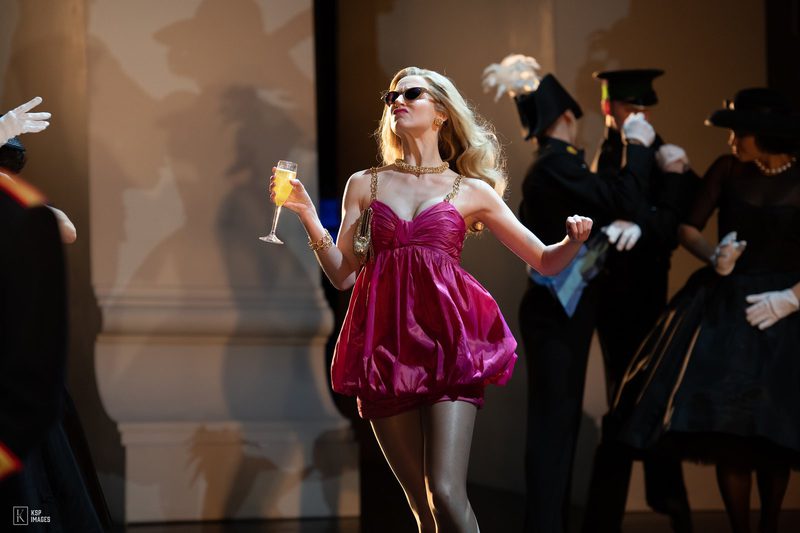
Theme Seven: Good vs Evil
In nearly every classical ballet the world over there is a theme of good vs evil, light vs dark, hope vs despair.
In traditional versions of Swan Lake, this is portrayed by the White Swan/Odette (innocence, honesty, integrity, purity) and the Black Swan/Odile (temptation, malevolence, corruption, villainy). In Matthew’s version, the role of the Black Swan doesn’t exist. Instead, portrayed by the same performer as the Swan, who appears as an intoxicating and mysterious visitor to a party at the Palace. Known simply as the Stranger, this bullish, testosterone-fuelled male figure (most definitely human not animal) represents everything the Prince isn’t it.
Stirring up the status quo in one fell-slap of his leather-clad trousers, this potent party-crasher fixes his focus firmly on the Queen. Meanwhile, the Prince can only watch on in horror and bewilderment as this man, who reminds him so much of the Swan, flirts outrageously with his mother, and casts him aside – quite literally. It is a heavy blow and the Prince’s emotions are ravaged.
In Act IV, the Swan becomes the Prince’s protector, during brutish nightmares (at least we believe they are imagined) in which both the Swan and the Prince are attacked by the swans. This is significant because it shows how power struggles can be lost and won, so easily, The Swan who had previously been protected by the swans, has also now become the object of their aggression.
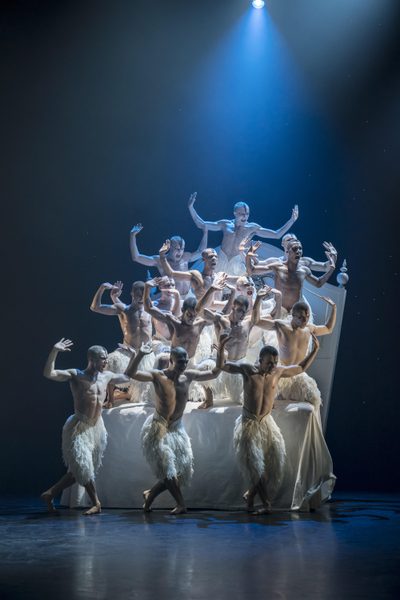
Matthew’s inspiration…
- The vicious and threatening behaviour of the swans on the bed at the end of Act IV is influenced by Alfred Hitchcock’s film, The Birds. In the film Tippi Hendren – the main actress – is surrounded by several birds who swoop on her as she sits on a bench. Soon the sky is filled with birds and they begin to attack her. This imagery is reflected in the choreography of the scene in which the swans swarm the Prince’s bed.
What to look out for?
- The intoxicating and alluring behaviour of the Stranger at the ball.
- The moment the Stranger draws a black mark down his face, reminiscent of the Swan.
- The menacing way the swans attack ‘en-mass’ and the way they circle the Prince and the Swan.
- The Swan cradling the Prince in his arms.
Theme Eight: Loss
At the end of the show it is hard not to feel that much has been lost. The Prince loses all hope for a better existence and subsequently loses his life, the Queen loses her son and not to forget the demise of the Unsuitable Girlfriend in Act Three. It is a powerful and provocative lesson on the impermanence of all things and the destructive nature of repression.
The reason we buy into this teaching so readily is because we are all familiar with the kinds of concepts Swan Lake explores. We all know someone struggling with the life they lead and looking for an escape. We have all experienced jealousy, longing and the devastation of the loss of someone we love.
We probably also have personal knowledge of the ripple effect that is caused by the death of an individual and the agony of unfulfilled potential.
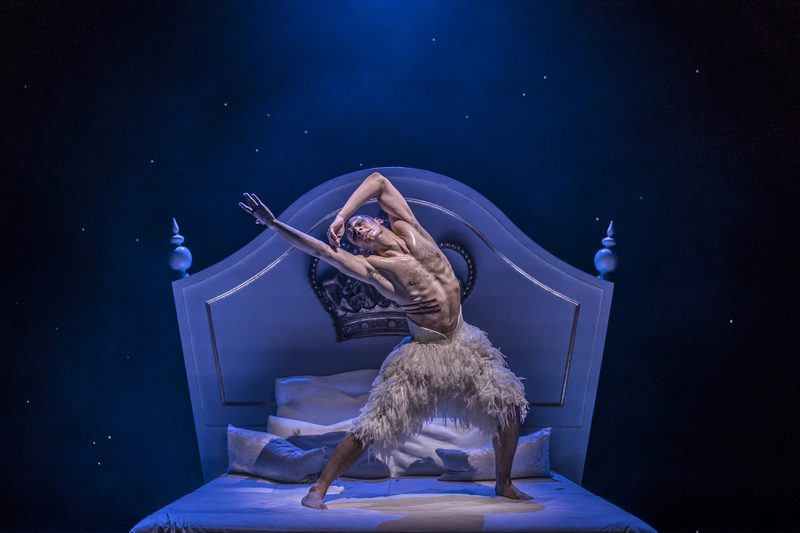
Theme Nine: Acceptance
The Prince yearns for acceptance. He is well-aware that his royal life sets him apart from everyone around him and it is a lonesome existence. He battles inwardly and outwardly against the stringent confines his position in society is determinate of and longs to be accepted as a regular person.
Yet, he is not the only one searching for acceptance. The Unsuitable Girlfriend is also craving validity, but lacks both the style, grace and social standing that is required.
The Queen seems by and large comfortable with the role that is expected of her as ruling monarch and she is much more accepting of the limitations is sets upon her.
The Prince’s interactions with the Swan, require him to mimic much of the Swan’s characteristics and mannerisms and in this way, he seeks acceptance into a new world. We are left to our own interpretations as to whether it is a ‘real’ world or simply a part of his imagination. Either way his voyage of discovery is spurred by an insatiable hunger to be accepted.

Matthew’s inspiration…
- Matthew recalls in his conversations with Alastair Macauley, that he was influenced by one of the very first productions of Swan Lake that he saw by Peter Darrell (performed by Scottish Ballet). Darrell’s treatment of the storyline is much more psychological than other versions, and includes the Prince experiencing opium-induced hallucinations. Matthew’s version also includes a blurring of what is real or imagined, which offers a freedom of interpretation for the viewer.
- Matthew was also influenced by the book ‘The Swan King (Ludwig II of Bavaria)’ which details the life of the Bavarian King, who was known for his odd and curious behaviour and his interest in swans. Though never resolved there was always a query as to whether Ludwig was clinically insane.
What to look out for?
- The sudden, and often-repeated, appearance and disappearance of the swans.
- The Prince’s querying of his own mental state and his inner torment.
- The treatment of the Prince by the Queen and her aides, after his apparent breakdown – reminiscent of electric-shock therapy, historically used to treat mental health issues.
If you’re affected by any of the themes in the show, please reach out to the following organisations for support:
Go Back